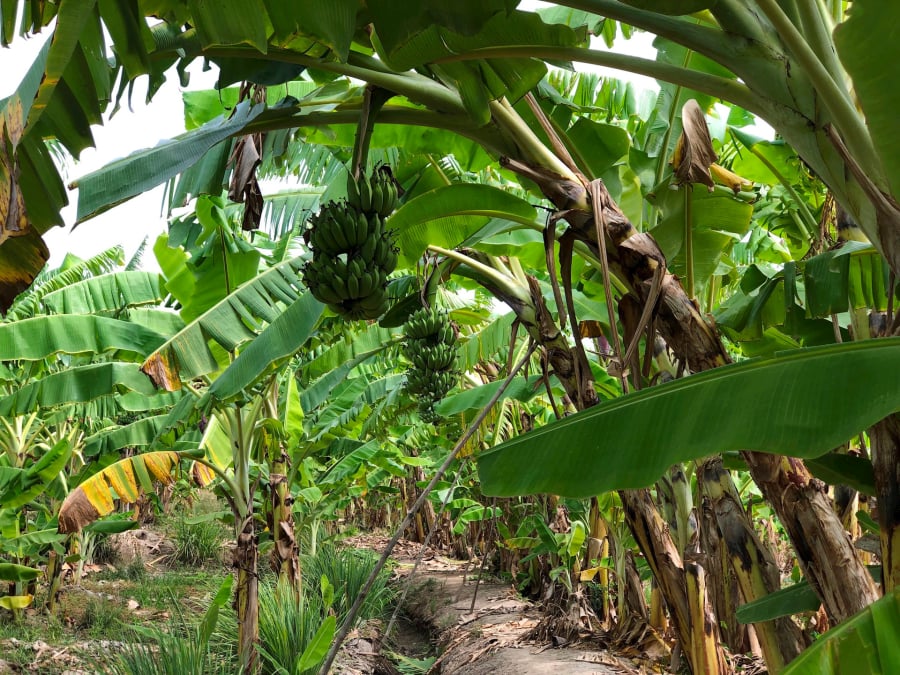In feng shui and folk culture, banana trees are often considered essential for maintaining a balanced living space. Traditional beliefs suggest that banana trees should be planted at the back of the house rather than the front. However, if there’s a utility pole in front of your house, it is recommended to plant banana trees there. But why are these suggestions made? Let’s explore the reasons behind these practices.
Why Are Banana Trees Typically Planted at the Back of the House?
An old saying goes, “Cau in front, banana at the back,” indicating that banana trees should be planted behind the house. According to traditional beliefs, this practice can bring about several benefits:
Shade and Climate Improvement: Banana trees have large, dense canopies that provide shade from the sun, especially the intense afternoon sun from the west. This not only reduces heat in the late hours but also blocks cold air from the north during winter. By planting banana trees at the back of your house, you can protect your home from harsh weather conditions while also lowering the indoor temperature.

Traditional saying: “Cau in front, banana at the back,” suggesting the ideal placement of banana trees.
Psychological and Physiological Influence: According to some scientific beliefs, banana trees absorb negative ions. These ions can cause feelings of laziness, lethargy, and reduced concentration. Therefore, planting banana trees at the back of the house, where there is less direct interaction with the family’s main activities, can minimize the negative influence of negative ions on daily life.
Why Plant Banana Trees in Front of a Utility Pole?
When there’s a utility pole in front of your house, many people believe that planting banana trees there can ward off bad luck. Here’s why:
Neutralizing Positive Ions: Utility poles often carry positive ion charges, making the air dry and hot. This can cause discomfort and restlessness for those living in the house. Banana trees, with their ability to absorb negative ions, can help neutralize these positive charges, soothing the air and reducing the sense of oppression.
Counteracting the Fire Element: In feng shui, a utility pole in front of the house is considered to create a “Fire Attack” situation, which can lead to financial, health, and personal issues. Planting banana trees, which have yin (feminine) characteristics, helps counteract the negative influence of the Fire element, creating a more balanced living environment.
Alternative Methods to Counteract the Effects of a Utility Pole in Front of the House
In addition to planting banana trees, there are two other ways to counteract the influence of a utility pole in front of your house:
Using a Bagua Convex Mirror: A Bagua mirror is shaped like a turtle shell with a convex mirror in the center. When placed in front of the house, it can dissipate negative energy and counteract the negative influence of the utility pole. However, placing the mirror must be done carefully and correctly, as incorrect placement may backfire, bringing bad luck instead of good fortune.
Building a Water Feature or Rock Garden: Constructing a fish pond, water body, or rock garden in front of the house not only creates an aesthetically pleasing landscape but also improves feng shui. Water represents the yin (feminine) element, increasing humidity and neutralizing positive ions. A water feature or rock garden helps soothe the environment, creating balance and bringing good luck to the homeowners.

Alternative Methods to Counteract the Effects of a Utility Pole
Planting banana trees at the back and front of your house each have their own significance and feng shui benefits. Banana trees at the back provide shade and reduce the negative impact of negative ions, while those planted in front can neutralize positive ions and ward off bad luck. In addition to planting banana trees, methods such as using a Bagua convex mirror or building a water feature can further enhance the feng shui of your living environment, creating a more harmonious space.
(*) The information in this article is for reference only and should not be solely relied upon.






























